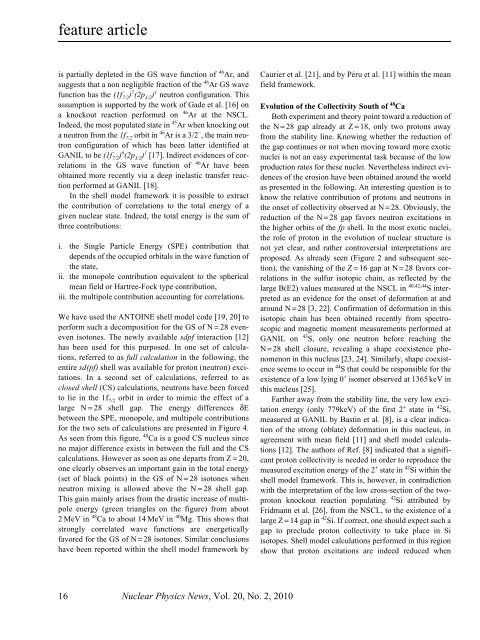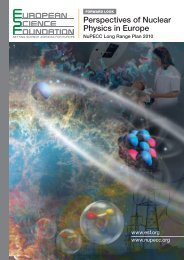Create successful ePaper yourself
Turn your PDF publications into a flip-book with our unique Google optimized e-Paper software.
feature articleis partially depleted in the GS wave function of 46 Ar, andsuggests that a non negligible fraction of the 46 Ar GS wavefunction has the (1f 7/2 ) 7 (2p 3/2 ) 1 neutron configuration. Thisassumption is supported by the work of Gade et al. [16] ona knockout reaction performed on 46 Ar at the NSCL.Indeed, the most populated state in 45 Ar when knocking outa neutron from the 1f 7/2 orbit in 46 Ar is a 3/2 − , the main neutronconfiguration of which has been latter identified atGANIL to be (1f 7/2 ) 6 (2p 3/2 ) 1 [17]. Indirect evidences of correlationsin the GS wave function of 46 Ar have beenobtained more recently via a deep inelastic transfer reactionperformed at GANIL [18].In the shell model framework it is possible to extractthe contribution of correlations to the total energy of agiven nuclear state. Indeed, the total energy is the sum ofthree contributions:i. the Single Particle Energy (SPE) contribution thatdepends of the occupied orbitals in the wave function ofthe state,ii. the monopole contribution equivalent to the sphericalmean field or Hartree-Fock type contribution,iii. the multipole contribution accounting for correlations.We have used the ANTOINE shell model code [19, <strong>20</strong>] toperform such a decomposition for the GS of N = 28 evenevenisotones. The newly available sdpf interaction [12]has been used for this purposed. In one set of calculations,referred to as full calculation in the following, theentire sd(pf) shell was available for proton (neutron) excitations.In a second set of calculations, referred to asclosed shell (CS) calculations, neutrons have been forcedto lie in the 1f 7/2 orbit in order to mimic the effect of alarge N = 28 shell gap. The energy differences δEbetween the SPE, monopole, and multipole contributionsfor the two sets of calculations are presented in Figure 4.As seen from this figure, 48 Ca is a good CS nucleus sinceno major difference exists in between the full and the CScalculations. However as soon as one departs from Z = <strong>20</strong>,one clearly observes an important gain in the total energy(set of black points) in the GS of N = 28 isotones whenneutron mixing is allowed above the N = 28 shell gap.This gain mainly arises from the drastic increase of multipoleenergy (green triangles on the figure) from about2MeV in 48 Ca to about 14 MeV in 40 Mg. This shows thatstrongly correlated wave functions are energeticallyfavored for the GS of N = 28 isotones. Similar conclusionshave been reported within the shell model framework byCaurier et al. [21], and by Péru et al. [11] within the meanfield framework.Evolution of the Collectivity South of 48 CaBoth experiment and theory point toward a reduction ofthe N = 28 gap already at Z = 18, only two protons awayfrom the stability line. Knowing whether the reduction ofthe gap continues or not when moving toward more exoticnuclei is not an easy experimental task because of the lowproduction rates for these nuclei. Nevertheless indirect evidencesof the erosion have been obtained around the worldas presented in the following. An interesting question is toknow the relative contribution of protons and neutrons inthe onset of collectivity observed at N = 28. Obviously, thereduction of the N = 28 gap favors neutron excitations inthe higher orbits of the fp shell. In the most exotic nuclei,the role of proton in the evolution of nuclear structure isnot yet clear, and rather controversial interpretations areproposed. As already seen (Figure 2 and subsequent section),the vanishing of the Z = 16 gap at N = 28 favors correlationsin the sulfur isotopic chain, as reflected by thelarge B(E2) values measured at the NSCL in 40,42,44 S interpretedas an evidence for the onset of deformation at andaround N = 28 [3, 22]. Confirmation of deformation in thisisotopic chain has been obtained recently from spectroscopicand magnetic moment measurements performed atGANIL on 43 S, only one neutron before reaching theN = 28 shell closure, revealing a shape coexistence phenomenonin this nucleus [23, 24]. Similarly, shape coexistenceseems to occur in 44 S that could be responsible for theexistence of a low lying 0 + isomer observed at 1365 keV inthis nucleus [25].Farther away from the stability line, the very low excitationenergy (only 779keV) of the first 2 + state in 42 Si,measured at GANIL by Bastin et al. [8], is a clear indicationof the strong (oblate) deformation in this nucleus, inagreement with mean field [11] and shell model calculations[12]. The authors of Ref. [8] indicated that a significantproton collectivity is needed in order to reproduce themeasured excitation energy of the 2 + state in 42 Si within theshell model framework. This is, however, in contradictionwith the interpretation of the low cross-section of the twoprotonknockout reaction populating 42 Si attributed byFridmann et al. [26], from the NSCL, to the existence of alarge Z = 14 gap in 42 Si. If correct, one should expect such agap to preclude proton collectivity to take place in Siisotopes. Shell model calculations performed in this regionshow that proton excitations are indeed reduced when16 Nuclear Physics News, <strong>Vol</strong>. <strong>20</strong>, <strong>No</strong>. 2, <strong>20</strong>10
















